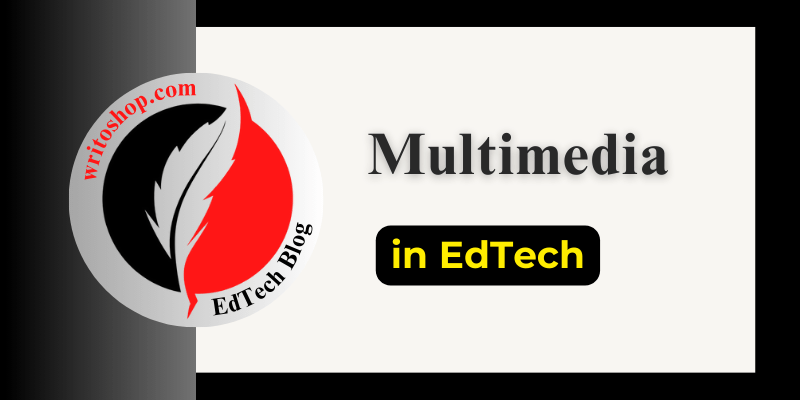
In the digital classroom, learning is no longer confined to blackboards and textbooks. Instead, it’s powered by images, videos, audio, animations, and interactive elements—all thanks to multimedia in educational technology.
Multimedia is one of the foundational pillars of modern EdTech (Educational Technology), providing engaging, visual, and interactive experiences that boost understanding and retention.
But what exactly is multimedia in educational technology? Let’s break it down.
What is Multimedia in Educational Technology?
Multimedia in educational technology refers to the integration of multiple forms of media—such as text, images, video, audio, graphics, and animations—to create dynamic and engaging learning environments.
Rather than relying on a single type of content, multimedia combines different sensory elements to enhance the teaching-learning process and appeal to various learning styles (visual, auditory, kinesthetic, etc.).
Types of Multimedia Used in Education
Text: The most basic form, used for definitions, instructions, and reading material.
Images: Photos, illustrations, and infographics support visual learning and help clarify complex concepts.
Audio: Narrations, sound clips, and music improve auditory learning and can also support language learning.
Video: Recorded lectures, animations, and documentaries are used to demonstrate real-life scenarios or dynamic processes.
Animations: Simulations and motion graphics explain processes like the water cycle or a chemical reaction in a way that static images can’t.
Interactive Elements: Quizzes, clickable diagrams, and drag-and-drop activities allow students to participate actively in their learning.
Real-Life Examples of Multimedia in Educational Technology
- Interactive E-books that include videos, quizzes, and animations alongside text
- Virtual science labs where students perform experiments through animated simulations
- Language learning apps using voice recognition and visuals to teach pronunciation and vocabulary
- History lessons with embedded maps, timelines, and documentary clips
- Gamified learning platforms that combine animation, music, and interactive storytelling
Benefits of Multimedia in Educational Technology
Improved Engagement: Multimedia captures students’ attention better than plain text or lectures, making learning more enjoyable.
Better Retention: Studies show that information presented through multiple formats (e.g., text + video) is easier to remember.
Supports Different Learning Styles: Some students learn best visually, others through sound or interaction. Multimedia ensures everyone benefits.
Real-World Simulations: Videos and animations help visualize abstract concepts, making learning more concrete and relatable.
Self-Paced Learning: Multimedia content is often accessible on-demand, allowing students to learn at their own speed.
Multimedia Tools in Educational Technology
Several EdTech tools and platforms help educators create or incorporate multimedia into their lessons:
Canva: For creating visuals and infographics
Kahoot!: Adds interactivity through quizzes and games
Powtoon & Animaker: Easy animation tools for explainer videos
Nearpod: Combines slides, videos, and live quizzes into one interactive lesson
YouTube & Vimeo: Platforms for hosting educational video content
H5P: Tool to create interactive videos, timelines, and more for LMS systems
Role of Multimedia in Different Learning Environments
In-Class Learning: Teachers use videos, smartboards, and digital slideshows to support lectures and group discussions.
Online Learning: E-learning platforms rely heavily on multimedia to deliver courses, making lessons more interactive and accessible remotely.
Blended Learning: Combines face-to-face instruction with multimedia-rich digital content, allowing learners to reinforce topics outside the classroom.
Challenges of Using Multimedia in Education
While multimedia is a powerful tool, it comes with some challenges:
Digital Access Inequality: Not all students have reliable access to devices or the internet.
Content Overload: Too many media types can overwhelm rather than aid learning.
Teacher Training: Educators need to be trained to effectively integrate multimedia into their lessons.
Copyright Issues: Using third-party media requires awareness of legal and licensing constraints.
The Future of Multimedia in EdTech
As technology advances, multimedia in education will become more immersive and personalized.
Innovations like augmented reality (AR), virtual reality (VR), and AI-generated content are already making their way into classrooms.
Imagine learning about the solar system through a VR headset or using AI tutors that adapt videos and animations to your personal learning speed.
These are no longer dreams—they’re the next phase of educational technology
Conclusion
Multimedia is not just an accessory in modern education—it’s a necessity.
It transforms static lessons into engaging experiences and supports deeper learning by making complex ideas easy to understand.
As digital education continues to grow, the use of multimedia will remain at the heart of effective, inclusive, and innovative teaching.
Whether you’re an educator, student, or EdTech creator, embracing multimedia is key to unlocking the full potential of 21st-century learning.
